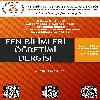Arduino ile Yer Çekim İvmesinin Hesaplanması
Son yıllarda Arduino’nun fizik eğitiminde kullanımı oldukça yaygınlaşmıştır. Fizikte deney yapmak, ölçüm alıp veri toplamak için Arduino Uno mikro denetleyicisini kodlamak bir alternatif olarak kullanılabilir. Bu araştırmada Arduino Uno kullanılarak yerçekim ivmesinin hesaplanmasına yönelik alternatif bir yöntem gösterilmeye çalışılmıştır. Parallax Data Acquisition Tool PLX-DAQ yazılımı kullanılmış, Arduino Uno üzerinden programlanan HC-SR04 ultrasonik mesafe sensörü ile eğik düzlem üzerinde serbest bırakılan arabanın zaman ve konum verileri toplanmış ve Microsoft Excel üzerine kaydedilmiştir. Farklı açılarda serbest bırakılan arabanın konum-zaman grafikleri excelde çizilmiş ve incelenmiştir. Serbest bırakılan arabanın hızlanan hareket yaptığı gözlenmiştir. Arabanın konum zaman verilerinden ortalama ivmesi hesaplanmış ve ivmenin açıya bağlı olarak değiştiği gözlenmiştir. Bu verilerden yararlanarak Newton’un dinamiğin temel kanunu kapsamında yerçekim ivmesi hesaplanmıştır. Yapılan araştırmada 50, 100, 150 ve 200 için g yerçekim ivmesi sırasıyla 9.62, 9.56, 10.04 ve 11.18 m/s2 olarak hesaplanmıştır
Anahtar Kelimeler:
Arduino, eğik düzlem üzerindeki hareket, g yerçekim ivmesi, ultrasonik mesafe sensörü
The Calculation of the Gravitational Acceleration with Arduino
The use of Arduino in physics education has become very common in recent years. In physics, make experiment, take measurements, and collect data to Arduino Uno microcontroller can be used to encode as an alternative. In this study, an alternative method for the calculation of the acceleration of gravity tried to be shown by using Arduino Uno. Parallax Data Acquisition Tool PLX-DAQ software was used, the time and location data of the car, which was the released on the inclined plane with the HC-SR04 ultrasonic distance sensor programmed via Arduino Uno, were collected and recorded on Microsoft Excel. Released at different angles of the car, positiontime graphs were drawn and examined in Excel. It was observed that the car that was released made accelerated movement. The average acceleration of the car’s position time data was calculated, and it was observed that the acceleration varied depending on the angle. Using this data, gravitational acceleration was calculated under Newton’s basic law of dynamics. In the research, g the gravitational accelerations for 5, 10, 15, and 20 degrees were calculated as respectively 9.62, 9.56, 10.04, and 11.18 m/s2
Keywords:
Arduino, motion on an inclined plane, g the gravitational acceleration, ultrasonic distance sensor,
___
- Arduino Home Page. (2019). https://www.arduino.cc/ adresinden alınmıştır [05.03.2019].
- Bouquet, F., Bobroff, J., Fuch-Gallezot, L. & Maurines, L. (2017). Project-based physics labs using low-cost open-source hardware. American Journal of Physics, 85(3), 216-222.
- Çolakoğlu, K. (1995). Serway Fen ve Mühendislik için Fizik. Palme Yayıncılık, Ankara.
- Çorlu, M.S. & Çallı, E. (2017). STEM Kuram ve Uygulamalarıyla Fen,Teknoloji, Mühendislik ve Matematik Eğitimi. Pusula 20 Teknoloji ve Yayıncılık, İstanbul.
- Duman, O. (2019). Eğitimde arduino kullanımı ile ilgili yapılan çalışmalar. XII. Uluslararası Eğitim Araştırmaları Kongresi. Rize.
- Fisher, D.K. & Gould, P.J. (2012). Open-source hardware is a low-cost alternative for scientific instrumentation and research. Modern Instrumentation, 1(2), 8-20.
- Franciole da Cunha, M. & Paulicci, L. (2016). Kinematic measurements using an infrared sensor. European Journal of Physics, 37(2). DOI:10.1088/0143-0807/37/2/025003.
- Galeriu, C. (2014). An arduino investigation of simple. The Physics Teacher, 52, 157- 159.
- Huang, B. (2015). Open-source hardware -- microcontrollers and physics education - ıntegrating dıy sensors and data acquisition with arduino. 122nd ASEE Annual Conference & Exposition, June 14-17, 2015, Seattle, WA.
- İzgöl, K. (2019). https://maker.robotistan.com/. Nisan 27, 2019 tarihinde https://maker.robotistan.com/arduino-dersleri-19-hc-sr04-ultrasonik-mesafe-sensorukullanimi/ adresinden alındı
- Kırıkkaya, E.B. & Başaran, B. (2017). Fizik laboratuvarında gerçekleştirilenelektrik deneylerinin arduino programı ile yeniden düzenlenmesi. IV. International Eurasian Educational REsearch Congress, 11-14 Mayıs 2017, Bayburt.
- Moya, A.A. (2018). An arduino experiment to study free fall at schools. Physics Education, 53(5), 055020, DOI: 10.1088/1361-6552/aad4c6.
- Music, P. (2017). Development of computer-based experiment set on simple harmonic motion of mass. The Turkish Online Journal of Educational Technology, 16(4), 1-11.
- Nichols, D. (2017). Arduino-based data acquisition into. The Physics Teacher, 55, 226- 227.
- Organtini, G. (2016). Scientific Arduino Programming. Roma.
- Sarı, U. & Kırındı, T. ( 2019). Using arduino in physics teaching: arduino-based physics experiment to study temperature dependence of electrical resistance. Journal of Computer and Education Research, 7(14), 698-710.
- Tate, R.D. (1968). Accerelation due to gravity at the national bureau of standards. Journal of Research of the National Bureau of Standards C. Engineering and Instrumentation, 72C (1), 21-26.
- Tong-on, A., Saphet, P. & Thepnurat, M. (2017). Simple harmonics motion experiment based on LabVIEW interface for Arduino. Journal of Physics: Conf. Series, (s. 901 (012114)).
- Yayın Aralığı: Yılda 2 Sayı
- Başlangıç: 2013
- Yayıncı: Fen Eğitimi ve Araştırmaları Derneği
Sayıdaki Diğer Makaleler
STEAM Yaklaşımına İlişkin Örnek Bir Uygulama ve Uygulama Hakkında Öğrenci Görüşleri
Neslihan ÜLTAY, Nisa EMEKSİZ, Rabiye DURMUŞ
Kuvvet Kapmaca’ Eğitsel Oyunu ile Fen Öğretimine Yönelik Öğretmen Görüşleri
Orhan KARAMUSTAFAOĞLU, Seyit BARAN
‘Kuvvet Kapmaca’ Eğitsel Oyunu ile Fen Öğretimine Yönelik Öğretmen Görüşleri
Orhan KARAMUSTAFAOĞLU, Seyit BARAN
Arduino ile Yer Çekim İvmesinin Hesaplanması
Mehmet Eren ÖZTEKİN, Meral GÜNGÖR BABAOĞLU, Kadir Kaan DURMAZ
Paşa YALÇIN, Zehra ÇAKIR, Sema ALTUN YALÇIN
Sınıf Öğretmenlerinin FeTeMM Farkındalıkları ve FeTeMM Eğitimi Uygulamalarına Yönelik Görüşleri
